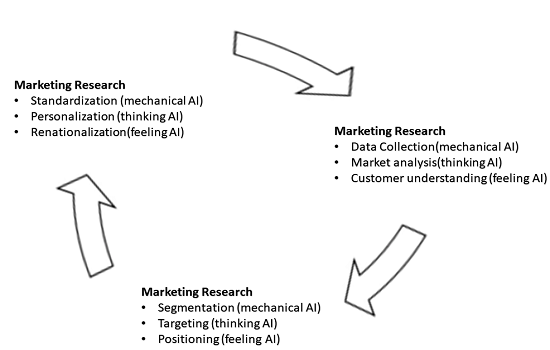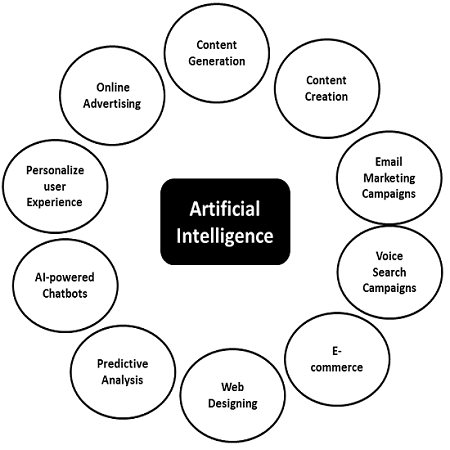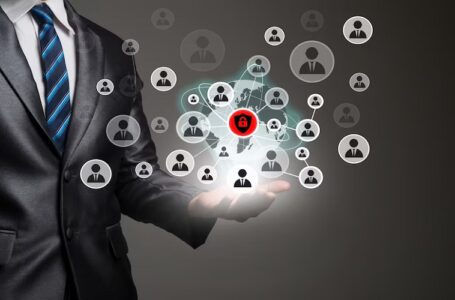Artificial Intelligence for Marketing to build stronger customer relationships.

Artificial intelligence (AI) technologies are being used in marketing to make automated judgments based on data gathering, data analysis, and further observations of audience or economic trends that may have an impact on marketing activities. When speed is crucial in marketing campaigns, AI is frequently used. To ensure optimum efficiency, AI technologies learn how to effectively engage with clients using data and customer profiles. They then give them personalized messages at the appropriate moment without assistance from marketing team personnel. AI is employed by many modern marketers to support marketing teams or to carry out more tactical jobs that don’t require as much human finesse.
How does AI work?
With the scale and effectiveness of a machine, AI simulates human thought processes to provide customized client experiences. By performing things as humans do, it gains experience and uses machine learning to better mimic and automate those actions. The information it gets determines what and how it learns. AI can quickly adapt to meet audience needs the more data it collects. It is accessible around the clock and with time will be able to perform more complicated tasks. Such talents are what make artificial intelligence such a potent marketing tool.
There are four typical uses of AI in marketing, and they can be divided into two groups based on how much human oversight is necessary to perform tasks and how adaptable the system is to take into account interactions and make adjustments in the future.

Components of AI in Marketing
To engage with consumers, marketers must use artificial intelligence. The most effective current methods for bridging the gap between the enormous volumes of customer data being collected and the practical next actions that can be used in future campaigns include the following elements of AI marketing
Machine Learning
Artificial intelligence (AI) is the driving force behind machine learning, which uses computer algorithms to analyze data and get better on their own over time. Machine learning-enabled devices examine new data in light of pertinent historical data so that judgments can be made based on what has or hasn’t worked in the past.
Big Data and Analytics
Big data has exploded with the advent of digital media, giving marketers the chance to comprehend their efforts and precisely attribute value across channels. As many marketers struggle to decide which data sets are worthwhile gathering, this has also resulted in an overabundance of data.
AI Platform Solutions
Marketers have a central platform for managing the vast amounts of data being acquired thanks to efficient AI-powered solutions. These systems can provide you with valuable marketing analytics about your target market, allowing you to make data-driven choices about how to communicate with them most effectively. Marketers, for instance, can better assess how receptive a customer is to a particular marketing attempt by using frameworks like Bayesian Learning and Forgetting.
Examples of AI for Marketing
It’s not always simple to witness AI in action, whether you’re just getting started with it or you’ve had years of expertise. Here are 10 examples of how AI is now used in marketing.

1 . Search Engines
For years, Google and Bing have used AI. Google introduced RankBrain in 2015, which makes use of machine learning to produce more pertinent search results. Bing launched Intelligent Search in 2017 to respond to user searches with more in-depth information and visuals.
Even with broad or incorrectly spelled queries, semantic search and natural-language processing assist consumers in finding more pertinent material on search engine results pages. For instance, users who search for “brown sandals” may get a variety of results, such as the top 10 brown sandals under $30, summer shoe trends, or strategies for cutting costs on their next pair of espadrilles. Retailers can benefit from this information by optimizing their content and items for search engines so that potential customers can find them.
2 . Content Strategy and Creation
The development of content strategy is significantly influenced by artificial intelligence. It aids marketing teams in selecting pertinent themes for conducting competition analysis and bettering their search engine optimization.
The use of AI in marketing also includes developing content. The AI technology known as “natural language processing,” or NLP, organizes data into texts that appear to have been produced by humans. Natural language generation is another name for this procedure. NLP can be used to produce content ranging from articles and white papers to social media posts, depending on the program. Two well-known news organizations that employ NLP are The Associated Press and The Washington Post. Retailers can also utilize this technology to generate product descriptions, publish more content at a lesser cost, and alter landing pages.
3 . Email Personalization
Email marketing can be personalized with the use of artificial intelligence. AI delivers helpful measures for marketers and uses behavioral information from previous subscribers to create more relevant and specialized messages. Marketers can personalize emails by using NLP technology:
- Subject lines, body copy, and calls to action
- Product recommendations
- Email automation workflows
- Drip campaigns
To send targeted content to their fans at the appropriate time, the Indiana Pacers and Indiana Fever leverage Salesforce Einstein technologies in Marketing Cloud.
4 . Chatbots
NLP is used by chatbots to simulate text-based human discussions. They streamline communication, offer round-the-clock coverage, and free up time for community and social media managers so they can concentrate on more subtle communications. Chatbots can be used by marketers to:
- Provide users with specific content
- Assist with customer service
- Generate new leads
With no need for human interaction, one specialized skincare retailer employs chat technology through Facebook Messenger and SMS to assist customers in identifying their skin type and provide product recommendations. Millennials and baby boomers both enjoy chatbots, demonstrating that this technology is not merely appealing to younger generations.
5 . Product Pricing
The science of AI-based dynamic pricing is developing. Businesses use data to assess demand and rivalry before influencing prices in real-time. For instance, artificial intelligence-based dynamic pricing, or “surge pricing,” as Uber calls it, is at work when you notice a spike in the price of an Uber after a concert.
A customer’s potential willingness to pay for a product can also be ascertained using data and this technology. With this knowledge, artificial intelligence can assess how a retailer’s prices stack up against those of its rivals. Ever discover a fantastic price on Amazon? Their third-party sellers frequently engage in price competition with one another using algorithms, enabling customers to shop around for the best deal.
6 . Image Recognition
In both still photos and moving pictures, AI-powered image recognition recognizes people and objects. Another chance for marketers to interact with customers on social media, particularly influencers, is through image analysis, where they may immediately offer them promotions and greetings. Large companies using this kind of software include Amazon, Facebook, and Pinterest, to name a few.
7 . Speech Recognition and Virtual Assistants
Today it seems like Siri, Google Assistant, and Alexa are everywhere. Additionally, technology is improving and becoming more human-like. Customers are becoming more accustomed to and at ease with this type of AI. See how Google Assistant makes a dinner reservation in this video.
However, customers’ top worries with voice-powered e-commerce continue to be trust and privacy. In a survey on voice, assistants conducted online and in-person with 1,000 Americans, 50% of participants have used one to make a purchase. But they also brought up concerns about protecting personal information, making payments securely, and preventing people from placing unauthorized orders, particularly children. Amazon is now in the lead when it comes to voice-powered eCommerce, but other merchants are prepared for it by cultivating individualized and trustworthy relationships with their clients.
8 . Augmented Reality
Retailers can interact with customers in a fun, non-intrusive way by using augmented reality (AR) advertising. An online retailer called Warby Parker makes use of AR. With the help of a computer-generated overlay over their face, customers of the eyewear retailer’s app can try on a pair of spectacles. The smart tape measure app Measured by Lowe’s from Lowe’s uses augmented reality (AR).
9 . Programmatic Ad Targeting
Retailers can design marketing campaigns for specific consumers with the aid of data and predictive analytics. Artificial intelligence can choose the most effective time of day to advertise and can even modify online ad bidding techniques.
Retailers like Lacoste are customizing advertisements based on consumer information. During one programmatic advertising campaign, Lacoste frequently changed up their creative, which led to 19,749,380 impressions and 2,290 sales across three countries. Your paid search and content marketing tactics can benefit from data from programmatic campaigns.
10 . Recommendation Engines
From Amazon to Netflix, AI-powered suggestions are used frequently. Predictive algorithms can offer content and products based on a combination of previous user behavior and individual interests. By removing decision fatigue and the requirement for manual page scrolling, retailers may employ AI to save customers time.




